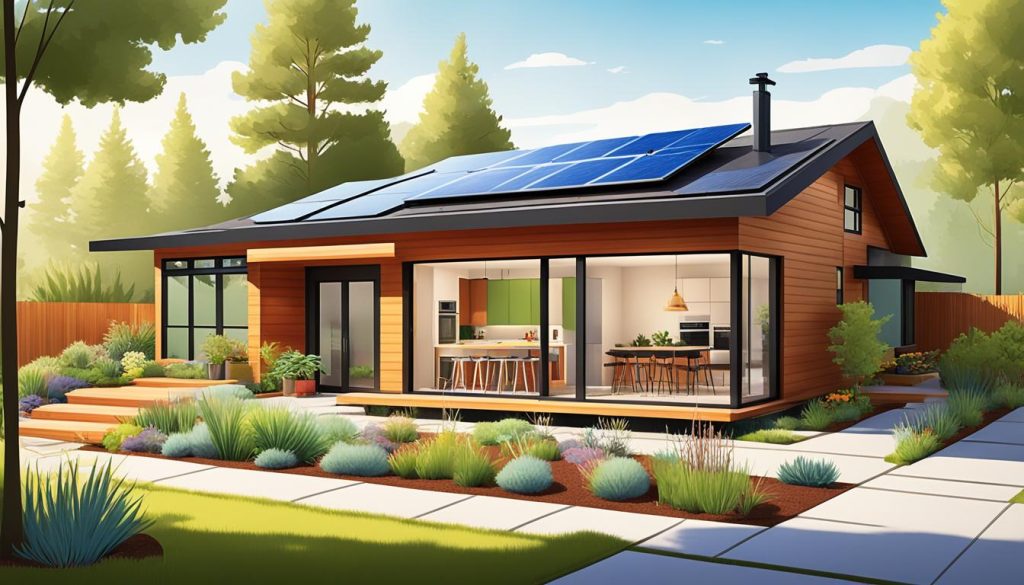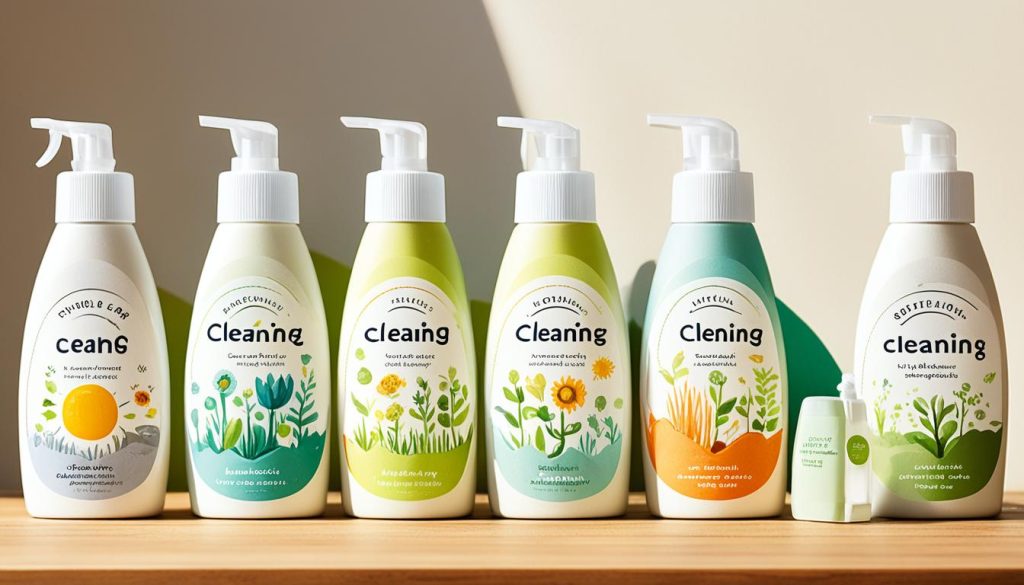Living an eco-friendly lifestyle doesn’t have to be expensive. With smart choices, you can save money and help the planet. This guide will show you how to live green without spending a lot1.
Key Takeaways
- Adopt energy-efficient practices like using LED light bulbs and solar panels to save on utility bills.
- Reduce waste and save money by investing in reusable products, composting, and buying secondhand items.
- Plan your meals and grow your own produce to cut food costs and minimize your environmental impact.
- Upgrade your home with smart thermostats, insulation, and high-efficiency appliances to boost energy savings.
- Prioritize sustainability and simplicity in your lifestyle to achieve long-term financial and environmental benefits.
How to Save Money on Green Living
Living an eco-friendly lifestyle doesn’t have to be expensive. Many sustainable choices can actually save you money over time2. By making smart choices and watching what you buy, you can lower your environmental impact and save money.
Reduce Consumption and Buy Quality
Reducing what you buy is a key way to save on green living2. Before buying something, think if you really need it or if you already have something that can do the job. Choosing quality over quantity can also save you money in the long run. High-quality items often last longer2.
Purchase Second-Hand Items
Buying used items, like furniture or clothes, can save you money and cut down on waste3. The clothing and footwear industry is a big source of greenhouse gases, and fast fashion hurts the environment4. Choosing second-hand or vintage items helps reduce your carbon footprint and your spending.
Plan Meals and Reduce Food Waste
Reducing food waste is a powerful way to save money on green living2. In the U.S., a lot of food, about 30-40%, ends up in the trash uneaten2. Planning meals, buying only what you need, and getting creative with leftovers can save you money and help the planet3. Buying local produce and choosing vegetables over meat can also save you money and be better for the earth4.
Small changes to your lifestyle can make a big difference for your wallet and the planet3. By buying less, choosing quality and second-hand items, and planning meals to waste less food, you can live green without spending more than usual2.
Eco-Friendly Home Improvements
Upgrading your home to be eco-friendly can cut your carbon footprint and save money. You can do this by installing solar panels or replacing old appliances with energy-efficient ones. These changes help you go green and save costs.
Install Solar Panels
Installing solar panels is a big step towards a greener home. Solar panels offer a reliable, sustainable energy source. They save the average U.S. household about one tonne of carbon per year5.
These panels cost about $16,000 to install but can pay for themselves in 10 years. This saves money and helps reduce greenhouse gas emissions, preserve water, and cut air pollution5.
Use Smart Thermostats
Smart thermostats are great for saving energy and money. They let you control your heating and cooling systems from anywhere. Homes with these thermostats use 16.5% less energy than those without5.
The Inflation Reduction Act offers $9 billion for home energy rebate programs. This includes money for installing smart thermostats6.
Replace Old Appliances with Energy-Efficient Models
Switching to Energy Star-rated appliances can cut your energy use and costs. For instance, Energy Star-rated ceiling fans are 60% more efficient than old models. This helps reduce air conditioning use, which is about 20% of Americans’ energy bills5.
The IRA also offers tax credits for making homes more energy-efficient. This includes credits for water heaters6.
By choosing these eco-friendly upgrades, you can save money and lessen your environmental impact. Don’t forget to use government incentives and rebates, like those from the Inflation Reduction Act, to save even more567.
Sustainable Living Habits
Living an eco-friendly life means focusing on natural cleaning products and biodegradable items8. The EPA says indoor air can be much more polluted than outside air because of harmful chemicals in cleaners8. By using natural cleaners or making your own with vinegar, lemon juice, and baking soda, you can lessen your environmental impact.
Being careful with what you buy also helps a lot8. Over $8.7 trillion is now being managed responsibly, pushing companies to be more sustainable. Choosing biodegradable items like recycled paper, natural shampoos, and bamboo toothbrushes reduces waste and your carbon footprint9. Americans use about 50 billion water bottles a month, costing between $1 and $2 each. So, sustainable options are cheaper and better for the planet.
Use Natural Cleaning Products
- Switch to natural, biodegradable cleaners
- Make your own cleaners with vinegar, lemon, and baking soda
- Choose products without harsh chemicals and focus on sustainability
Choose Biodegradable Products
- Go for recycled toilet paper, natural shampoos, and bamboo toothbrushes
- Avoid plastics and disposable items when you can
- Support companies that care about the planet
“By making small, sustainable changes in our daily lives, we can collectively have a significant impact on the health of our planet.”
These sustainable habits are good for the planet and can save you money9. Making your own cleaners is safer and cheaper than buying them, and using less of them can make your money last longer9. Plus, simple actions like using a shower timer and washing full loads can cut down your utility bills.
Every step towards a greener lifestyle counts. By using natural cleaners and biodegradable products, you’re helping the planet and saving money8. If we all adopted regenerative farming, it could even help reverse the climate crisis, showing how important sustainable choices are8910.
Energy-Saving Home Upgrades
We all want to cut our utility bills and help the planet. Luckily, there are ways to do this with home upgrades. Let’s look at three great options to boost your home’s energy efficiency.
Insulate Your Home
Improving your home’s insulation is a big step. It helps keep heat in and saves energy11. The National Association of Homebuilders says most American homes lack enough insulation11. Sealing air leaks around windows and doors also saves energy and money11.
Seal Drafts and Air Leaks
Sealing drafts and air leaks is key to saving energy11. These leaks can waste a lot of energy11. Fixing these spots can cut your bills and help the environment.
Replace Your Boiler with a High-Efficiency Model
Think about getting a new, efficient boiler11. Heat pumps use less energy than old systems, and you can save on installation costs11. These boilers cut heating costs and emissions.
These upgrades mean lower bills, a cozy home, and less pollution12. Energy from our homes makes up 28 percent of global carbon emissions12. Upgrading is good for your wallet and the earth.
Every step towards energy efficiency helps. Start with what you can afford and need for your home. You’ll be moving towards a greener, cheaper living space.
Conclusion
This article has shown you how to save money and live more eco-friendly. You can cut down on what you buy and choose second-hand items13. Making your home more energy-efficient14 and living sustainably are also great ways to help the planet and save money. By making smart choices and small changes, you can move towards a greener lifestyle that’s good for your wallet and the earth.
Important tips include reducing food waste13, choosing tap water over bottled water13, and using community resources to save cash13. Also, investing in eco-friendly home upgrades like solar panels and smart thermostats can save you money on bills over time14.
Starting your journey to a sustainable lifestyle should be slow and easy. Begin with small changes and focus on recycling15. By doing this, you can slowly change your life to be both green and smart with money. This article’s conclusion summarizes the main points, helping you move forward to a greener and cheaper future.
FAQ
How can I reduce consumption and focus on quality over quantity?
Where can I find affordable second-hand items?
How can I reduce food waste and save money on groceries?
What eco-friendly home improvements can save me money in the long run?
How can I make my cleaning and personal care routine more sustainable?
What home upgrades can improve energy efficiency and lower my utility costs?
Source Links
- 13 Ways to Go Green and Save Money
- Green and Thrifty: Eco-Friendly Living on a Tight Budget
- Sustainable Living Guide: Tips and Tricks for Frugal Green Living
- Sustainable spending – how to go green and save money –
- 8 Eco-Friendly Home Improvements And How They Make A Difference
- Eco-Friendly Home Improvements That Make a Difference | Bankrate
- The best eco-friendly home improvements you can do for less than $100
- Green Living: 10 Habits of Highly Sustainable People
- 20 Frugal habits for an eco-friendly lifestyle
- How to save money with sustainable choices
- The 8 Best Energy Efficient Home Upgrades
- 10 Low-Cost Ways To Make Your Home More Energy-Efficient | Bankrate
- 10 Ways Seniors Can Save Money by Green Living
- Economics of Eco-Friendly Home Loans
- Vision Realty & Management



